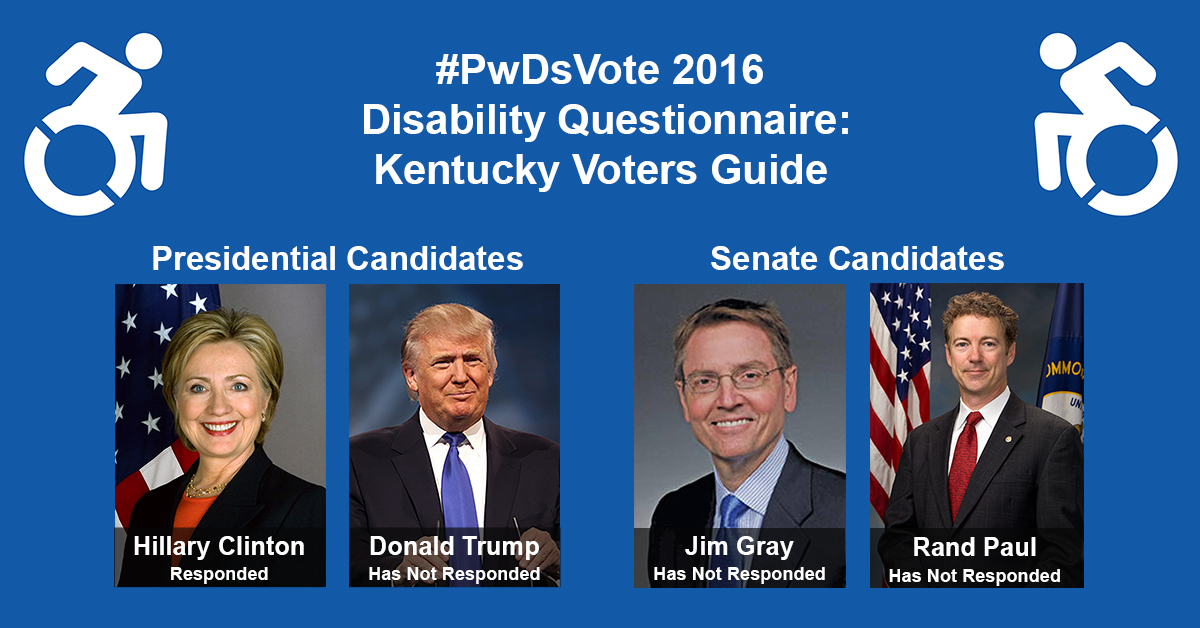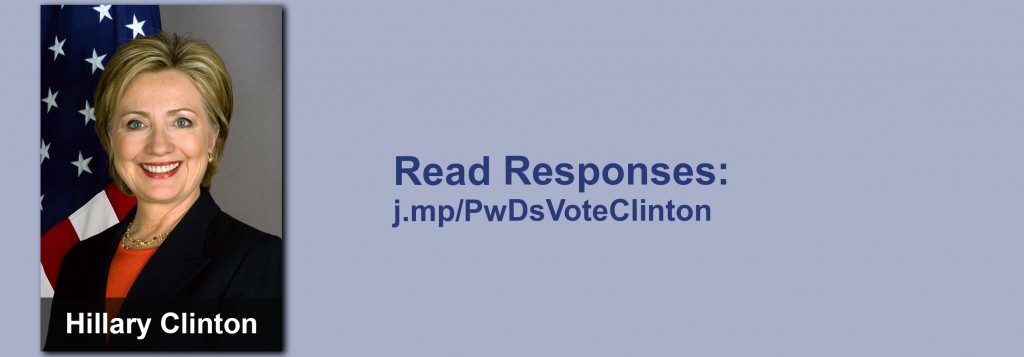Washington, Oct. 13 – As voters get ready to head to the polls in Kentucky, RespectAbility is releasing its Kentucky Disability Voter Guide for the upcoming presidential and senate elections. Democrat Jim Gray is challenging Republican incumbent Rand Paul for the senate seat. Unfortunately for the 734,781 citizens in Kentucky with a disability, neither have completed the #PwDsVote Disability Campaign Questionnaire for Senate and Gubernatorial Candidates for people with disabilities. On the presidential level, Democrat Hillary Clinton has completed the questionnaire while Republican Donald Trump has yet to do so.
The #PwDsVote 2016 Campaign Questionnaires were designed by and for people with disabilities (PwDs) and those who love them to know where candidates stand on key issues. RespectAbility is nonpartisan and does not endorse candidates. The questionnaires are purely for educational purposes as voters go to the polls.
The presidential questionnaire was created during the primary season and asked all of the presidential candidates to comment on 16 disability questions. Former Secretary of State Hillary Clinton responded by addressing all of the questions. Despite numerous requests in person and by phone and email, the Trump campaign has not yet filled out the questionnaire. The American Association of People with Disabilities and the National Council on Independent Living also has a nonpartisan presidential questionnaire, which both Clinton and Trump have completed. Libertarian Gary Johnson and Green Party candidate Jill Stein have not filled out either questionnaire.
The down-ballot survey was adapted from the presidential questionnaire to ask gubernatorial candidates 16 questions and senatorial candidates 17 questions. All answers are posted verbatim and in full on The RespectAbility Report, a publication that covers the intersection of disability and politics.
Kentucky faces significant barriers in terms of empowering more people with disabilities to pursue employment. The state’s employment rate for people without disabilities lies at 74.4 percent. Meanwhile, only 27.3 percent of working-age Kentuckians with disabilities statewide are employed, the third lowest in the nation. This election cycle brings with it an opportunity to improve this aspect, as well as to increase and improve opportunities for competitive, integrated employment for people with disabilities. Voters are looking to know where the candidates stand on important disability issues so that they can help improve these efforts
Kentucky Needs to Improve Outcomes for Citizens with Disabilities
There are 432,038 Kentuckians with disabilities who are between the ages of 18-64. Additionally, there are 21,400 Kentuckians ages 16-20 with disabilities. More than 80,000 Kentucky students have individual education plans (IEPs). However, many Kentuckians with disabilities have not yet received a disability diagnosis they need, and thus are not yet receiving the school accommodations and supports that they need to succeed. Many students who might need support to succeed academically instead find themselves trapped into a lifetime of poverty or flowing down the school to prison pipeline.
Kentucky has the opportunity to work hard to improve outcomes in terms of competitive, integrated employment for people with disabilities with the upcoming election. Currently only 27.3 percent of working-age Kentuckians with disabilities are employed compared to 74.4 percent of those without disabilities. View the rankings of all 50 states and compare.
RespectAbility, founded in 2013, is a nonpartisan, nonprofit organization working to end stigmas and advance opportunities for people with disabilities. It has submitted comments for all 50 state’s drafts of the Unified Plan as required under Section 102 of the Workforce Innovation and Opportunity Act (WIOA). Kentucky’s’ WIOA plan contains detailed plans related to accessibility and barrier solutions regarding career center services. The plan to have secure wireless services at comprehensive one-stops and allow services to be accessible from many locations is crucial for people with barriers to work, such as transportation, as it allows them to receive the necessary services they otherwise might now be able to access. Kentucky also will be focusing on in-demand industry sectors as well as apprenticeships, which are an important avenue to self-sufficiency and higher wages for youth with barriers to employment. This is critical work and it is pleasing to see that progress is being made in this aspect.
One of the most important facets of WIOA is that it raises expectations for youth with disabilities and assists states to provide them with the supports they need to ensure success. Kentuckians with disabilities are an untapped resource that can be trained to bridge that gap. Indeed, a recent detailed study by the Kessler Foundation and the University of New Hampshire shows the 70 percent of working age people with disabilities are striving for work.
Evidence shows that people with disabilities can provide a wonderful solution to companies and other employers that want to succeed. The diverse skills, greater loyalty and higher retention rates of people with disabilities are already starting to meet employer talent needs in increasing numbers around America. With WIOA, Kentucky can benefit from that progress if it truly breaks down silos within government agencies and partners, and lets innovation, based on evidence-based practices, take place.
However, the gap in the labor force participation between people with and without disabilities is still too large around the entire country. This lack of employment for people with disabilities creates poverty, powerlessness, and poor health. Polls and studies show that people with disabilities want the opportunity to have the dignity and independence that jobs provide.
America has 1.2 million youth with disabilities, between the ages of 16 and 20. Each year 300,000 of them age into what should be the workforce, but stigmas and lack of knowledge about the capabilities of people with disabilities means that most do not find employers willing to hire them. Young adults with disabilities in all of these states are hoping to find work. They have high expectations and deserve the opportunity to achieve the American dream. Young people with disabilities may simply need some thoughtful help to transition into the workforce. See data on all 50 states here: State Data.
Fully one-out-of-five people have a disability, and 52 percent of likely voters have a loved one with a disability. Only 34 percent of working-age Americans with disabilities have jobs, despite the fact that the vast majority want to work. More than 11 million working age people with disabilities are now living on government benefits in our country.
RespectAbility President Jennifer Laszlo Mizrahi said, “Our community is looking for jobs so we can achieve the American dream, just like anyone else. It is vital for us to know where the candidates stand on economic, stigma, education, safety, transportation, housing, healthcare, foreign affairs and other issues. The candidates have hugely different ideas about how to deal with the issues. Thus, it’s extremely important to read their full answers so you can understand their vast differences.”
Remember to Vote
Kentucky residents can vote for the candidates of their choice either on the standard voting schedule or through early voting and absentee ballots. Kentuckians had until Oct. 11, 2016, to register to vote for the presidential general election. Registered voters can cast an early vote from Oct. 21, 2016 through Nov. 7, 2016 at their local county clerk’s office if they qualify for an absentee ballot. Voters can apply for an absentee ballot through the mail by sending an absentee ballot request to the county clerk. More information regarding absentee voting can be found at: Absentee Voter Information.







Be First to Comment